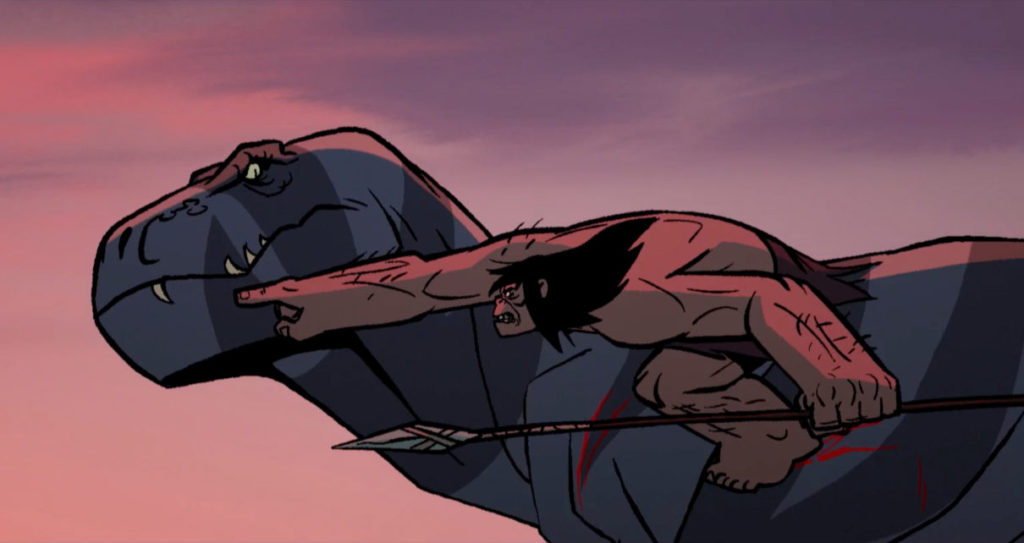A new Genndy Tartakovsky animated series is always a major event. But after the successful return of Samurai Jack, which Adult Swim put out for an adult audience years after Cartoon Network released the original series for children, a question arose: would Tartakovsky continue making violent, badass projects between his child-friendlier time on Hotel Transylvania sequels and spinoffs? The answer is clear from the start in Primal, a dialogue-free prehistoric pulp fiction bloodbath of a series, which will see its first five episodes air this week on Adult Swim and a final five at a later date. We spoke with Tartakovsky about the show’s themes, the choice to axe voice acting, and why he decided to make a show about a caveman riding a dinosaur. (The answer was obvious: Why not?)
What made you want to make a show about survival and extinction? Why now?
I had this idea that started out as a kid show, about a dinosaur and a kid. The story never went anywhere, so I took a break from it. But after the last season of Samurai Jack, which was so successful and for adults, I wanted to do something different. The reaction to Jack, especially to the visual sequences, was ecstatic. And, of course, the idea of a man riding a dinosaur is fun, so we went back to it. As for the survival stuff, it really all came from the name. Primal. It’s everything that’s raw.
Do you see a throughline from Samurai Jack to Primal?
Actually, we wanted to do something very different. But I think the throughline is in the artistic sensibility. I’ve been trying to do a similar thing ever since the days of Dexter’s Laboratory—there’s an energy and emotion to my work, and I think Primal is the best example of that. But we did 62 episodes of Jack, and you learn a lot of different ways to tell a story. This, funnily enough, felt like the natural evolution.
What constraints, and what freedoms, come with a show entirely without voice actors and dialogue? How did the dialogue-free style inform the music, the storyboarding, and artistic choices?
That’s actually something that we’re very comfortable with, because we’ve done it a bunch in small portions. Taking it into a whole story? That was more challenging. Each episode of Primal is very different from the others, and by the time we get into the later episodes, stuff gets really complicated. But it’s very freeing, because it’s for adults, not kids. Adults can fill in gaps in storytelling, if they’re paying attention. At the beginning, I was sort of nervous that people were going to scream at the TV and go, “Come on, Say something!” But once the sound effects, music, and everything else started to fill in around the storyboards, we weren’t worried at all.
What influenced this show most visually and in terms of its world? Something like Jonny Quest?
Not at all. I try very hard not to reference other animation. The inspiration, really, was old pulp novels, mostly by Robert E. Howard, who wrote Conan the Barbarian. The storytelling style is very pulp. Each episode is like a pulp short story: you drop in, some stuff happens, and the character has to deal with it. Visually, the crew and I are kids of the 1970s, so there’s a connection to ’70s filmmaking too—the grittiness, the rawness of Sergio Leone, Kurosawa, The French Connection.
We also wanted it to look different from Samurai Jack, so there’s almost a little push toward the works of Ralph Bakshi—Wizards and stuff—plus ’70s sci-fi paintings. Christian Schellewald had a hand in that. He did all the background drawings. He’s a German guy, and he has this illustrative, almost Moebius-type style. That defined what everything would look like for us. We even kept the line-work over the color, which was very new for us.
Studio La Cachette’s work on Love, Death & Robots on Netflix is also pretty violent. Was there any artistic overlap there? What pushed you to work with them?
I really liked Studio La Cachette’s sensibilities, from their shorts in particular. And with Primal, I wanted to do something new in television. I wanted to have more creativity, in a way. Challenging the status quo with this no-dialogue thing meant the animation would have to be at the next level. Luckily, they knew my work, and I sent them my first storyboard, and they loved it. Initially, they were only going to work with us on the pilot, but when I saw their work come in, I realized that it was a perfect match, and they agreed to do the full 10 episodes.
Do you see this as a show about trauma as much as one about survival?
We didn’t want to do violence for violence’s sake just because we could put in a lot of great action sequences. It’s all about the characters. But because it’s a primordial, brutal world, I wanted to simplify everything and base it on survival. And survival is traumatic. There’s loss and emotion. Everything is on your sleeve. There’s no hiding. There’s no psychology. Everything is black and white. We needed this simple brutality, but without choreography.
It’s an interesting challenge, because to watch this show, you really have to let the story and visuals guide you to where it’s going. I wanted to get across this raw motion and energy, and make things so tense that you’d be on the edge of your seat. I wanted to see if that was possible with animation. The no-dialogue part makes you focus, pay attention. I’m doing things differently than I ever have done. It’s more experimental, but it seems to be working.
Thanks for reading The Dot and Line, where we talk about animation of all kinds. Don’t forget to follow us on Twitter and sign up for our newsletter.
